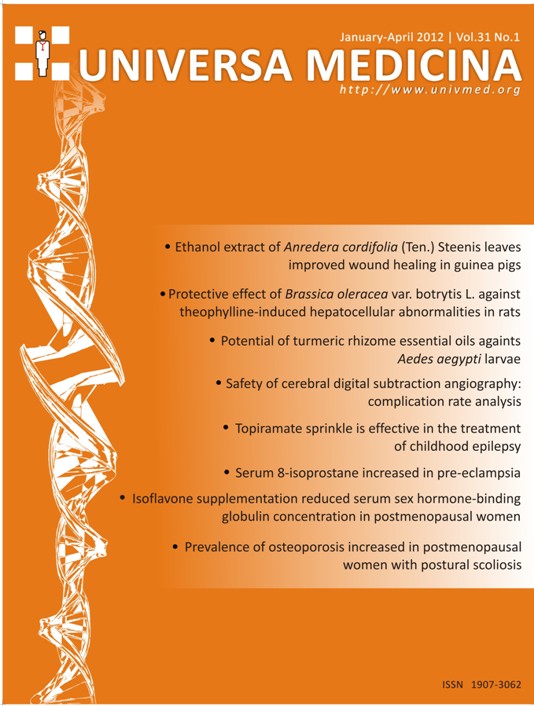Serum 8-isoprostane increased in pre-eclampsia
Main Article Content
Abstract
Background
The main causes of maternal mortality in Indonesia are pre-eclampsia, hemorrhage, and infection. Oxidative stress has a primary role in pre-eclampsia and one of its parameters is 8-isoprostane serum level. The objective of this study is to measure 8-isoprostane and to analyze the relationship between 8-isoprostane level and birth weight in pre-eclampsia.
Methods
A cross-sectional study involving 23 pre-eclampsia and 29 normotensive pregnant women with normal or cesarean delivery at Dr. Kariadi Hospital Semarang from January to May 2011. Collected maternal blood samples were assessed for 8-Isoprostane levels by means of a specific ELISA kit. Neonatal birth weight was measured immediately after delivery by means of calibrated baby scales. Differences in 8-isoprostane levels between pre-eclampsia and normotensive women were assessed using independent t-test for normal distributed data, and the Mann-Whitney test for non-normally distributed data.
Results
Mean 8-isoprostane level was significantly higher in women with pre-eclampsia than in normotensive women (62.52 ± 12.19 pg/mL vs 28.64 ± 8.81 pg/mL) (p<0.05). Low birth weight was twice as frequent in pre-eclampsia than in normotensives. There was no correlation between 8-isoprostane serum level and neonatal birth weight in pre-eclampsia.
Conclusion
The level of 8-isoprostane was higher in pre-eclampsia than in normotensives. It is recommended to conduct further studies to determine whether 8-isoprostane may be used as a predictive marker of pre-eclampsia.
Article Details
Issue
Section
The journal allows the authors to hold the copyright without restrictions and allow the authors to retain publishing rights without restrictions.
How to Cite
References
Gupta S, Aziz N, Sekhon L, Agarwal R, Mansour G, Li J, et al. Lipid peroxidation and antioxidant status in pre-eclampsia: a systematic review. Obstet Gynecol Surv 2009;64:750-9.
Andrian G, Wikjosastro GH, Waspodo D. Buku Acuan Nasional Pelayanan Kesehatan Maternal dan Neonatal. Jakarta. Yayasan Bina Pustaka Sarwono Prawiroharjo;2001.
Staff AC, Dechend R, Pijnenborg R. Learning from the placenta: acute atherosis and vascular remodeling in pre-eclampsia–novel aspects for atherosclerosis and future cardiovascular health. Hypertension 2010;56:1026-34.
American College of Obstetricians and Gynecologists. ACOG practice bulletin: diagnosis and management of pre-eclampsia and eclampsia. Int J Gynaecol Obstet 2002;77:67-75.
Pasouglu H, Bulduk G, Ogus E. Nitric oxide, Lipid peroxides (MDA), an uric acid levels in pre-eclampsia and eclampsia. Tohoku J Exp Med 2004;202:87-92.
Desai P, Rathod SP, Garge V, Mansuri Z. Evaluation of pro-oxidants and antioxidants in pre-eklampsia. J Obstet Gynecol Ind 2003;53: 445-8.
Barden A, Beilin LJ, Ritchie J, Croft KD, Walters BN, Michael CA. Plasma and urinary 8-iso-prostane as an indicator of lipid peroxidation in pre-eclampsia and normal pregnancy. Clin Sci 1996;91:711-8.
Mandang S, Manuelpillai U, Wallace EM. Oxidative stress increases placental and endothelial cell activin A secretion. J Endocrinol 2007;192:485–93.
Ouyang YQ, Li SJ, Zhang Q, Cai HB, Chen HP. Interactions between inflammatory and oxidative stress in pre-eclampsia. Hypertens Pregnancy 2009;28:56-62.
Sharma JB, Sharma A, Bahadur A, Vimala N, Satyam A, Mittal S. Oxidative stress markers and antioxidant levels in normal pregnancy and pre-eclampsia. Int J Gynaecol Obstet 2006;94: 23-7.
Zhao S, Gu Y, Lewis DF, Wang Y. Predominant basal directional release of thromboxane, but not prostacyclin, by placental trophoblasts from normal and preeclamptic pregnancies. Placenta 2008;29:81-8.
Tsukimori K, Nakano H, Wake N. Difference in neutrophil superoxide generation during pregnancy between pre-eclampsia and essential hypertension. Hypertension 2007;49:1436–41.
Ishihara O, Hayashi M, Osawa H, Kobayashi K, Takeda S, Vessby B, et al. Isoprostanes, prostaglandins and tocopherols in pre-eclampsia, normal pregnancy and non-pregnancy. Free Rad Res 2004;913-8.
Gupta S, Agarwal A, Sharma RK. The role of placental oxidative stress and lipid peroxidation in pre-eclampsia. Obstet Gynecol Surv 2005;60: 807-16.
Szymonowicz W, Yu VYH. Severe pre-eclampsia and infants of very low birth weight. Arch Dis Child 1987;62:712-6.
Xiong X, Demianczuk NN, Saunders LD, Wang FL, Fraser WD. Impact of pre-eclampsia and gestational hypertension on birth weight by gestational age. Am J Epidemiol 2002;155:203-9.
Granger JP, Alexander BT, Linas MT, Bennett WA, Khalil RA. Pathophysiology of pre-eclampsia: linking placental ischemia/hypoxia with microvascular dysfunction. Microcirculation 2002;9:147-60.
Zahumensky J. Doppler flowmetry in pre-eclampsia. Bratisl Lek Listy 2009;110:432-5.
Gant NF, Hutchinson HT, Siiteri PK, MacDonald PC. Study of the metabolic clearance rate of dehydroisoandrosterone sulfate in pregnancy. Am J Obstet Gynecol 1971;111:555-63.
Sebire NJ, Goldin RD, Regan L. Term pre-eclampsia is associated with minimal histopathological placental features regardless of clinical severity. J Obstet Gynaecol 2005;25: 117-8.
Rodrigo R, Parra M, Bosco C, Fernández V, Barja P, Guajardo J, et al. Pathophysiological basis for the prophylaxis of pre-eclampsia through early supplementation with antioxidant vitamins. Pharmacol Ther 2005;107:177-97.
Vadillo-Ortega F, Perichart-Perera O, Espino S, Avila-Vergara MA, Ibarra I, Ahued R, et al. Effect of supplementation during pregnancy with L-arginine and antioxidant vitamins in medical food on pre-eclampsia in high risk population: randomised controlled trial. BMJ 2011;342: d2901.doi:10.1136/bmj.d2901.


